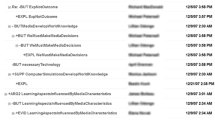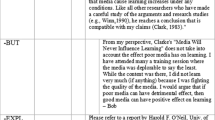Abstract
In this study we examined response patterns in exchanges between males and females and their effects on gender participation in five online debates. Students classified messages into arguments, evidence, critiques, and elaborations while posting messages to the debates to facilitate argumentation and the sequential analysis of message-response sequences. The findings revealed no differences in number of critiques posted in response to arguments because females were just as likely as males to critique messages from both males and females, and because females responded to males with critiques at a higher than expected frequency. Posthoc analysis revealed strong indications that females posted fewer rebuttals to the critiques of females than males, and males posted more rebuttals to the critiques of females than females. The methods used in this study illustrate a process-oriented approach to explain and predict gender differences in participation and serve as a framework for future research on gender participation, group interaction, and strategies for facilitating collaborative argumentation and problem solving.
Similar content being viewed by others
References
Allen, B. J. (1995). Gender and computer-mediated communication. Sex Roles, 32(7/8), 557–563.
Bakeman, R., & Brownlee, J. (1982). Social rules governing object conflicts in toddlers and preschoolers. In K. H. Rubin & H. S. Ross (Eds.), Peer relationships and social skills in childhood (pp. 99–111). New York: Springer-Verlag.
Bakeman, R., & Gottman, J. (1997). Observing Interaction: An introduction to sequential analysis, Cambridge, University Press.
Baker, M. (1999). Argumentation and constructive interaction. In P. Coirier & J. Andriessen (Eds.), Foundations of argumentative text processing, (pp. 179–202). Amsterdam: Amsterdam University Press.
Bakhtin, M. (1981). Discourse in the novel (M. Holquist & C. Emerson, Trans.). In M. Holquist (Ed.), The dialogic imagination, (pp. 259–422). Austin, TX: The University of Texas Press.
Baym, N. (1996). Agreements and disagreements in a computer-mediated discussion. Research on Language and Social interaction, 29(4), 315–345.
Blum, K. (1999). Gender differences in asynchronous learning in higher education: Learning styles, participation barriers and communication patterns. Journal of Asynchronous Learning, 3(1). Retrieved on March 3, 2004 from http://www.sloan-c.org/publications/jaln/vSnl/index.asp.
Butler, D., & Geis, F. L. (1990). Nonverbal affect responses to male and female leaders: Implications for leadership evaluations. Journal of Personality and Social Psychology, 59, 48–59.
Carr, C., & Anderson, A. (2001). Computer-supported collaborative argumentation: Supporting problem-based learning in legal education. Paper presented at the Computer Support for Collaborative Learning (CSCL) 2001 Conference. Retrieved October 30, 2003: http://www.mmi.unimaas.nl/euro-cscl/Papers/25.pdf.
Cho, K., & Jonassen, D. (2002). The effects of argumentation scaffolds on argumentation and problem solving. Educational Technology Research and Development, 50 (3), 5–22. Retrieved March 3, 2004: http://tiger.coe.missouri.edu/jonassen/Argumenta-tion.pdf
Davidson-Shivers, G. V., Morris, S., & Sriwongkol, T. (2003). Gender differences: Are they diminished in on-line discussions? International Journal on E-Learning, 2(1), 29–36.
Davidson-Shivers, G. V., Muilenburg, L., & Tanner, E. (2000, June). Synchronous and asynchronous discussion: What are the differences in student participation? Ed-Media 2000: World Conference on Educational Multimedia, Hypermedia & Telecommunications. Montreal, Quebec, Canada.
Davidson-Shivers, G. V., Muilenburg, L., & Tanner, E. (2001). How do students participate in synchronous and asynchronous on-line discussions? Journal of Educational Computing Research, 25, 351–366.
Dillenbourg, P., Baker, M., Blaye, A., & O’Malley, C. (1996). The evolution of research on collaborative learning. In E. Spada & P. Reiman (Eds.), Learning in humans and machine: Towards an interdisciplinary learning science, (pp. 189–211). Oxford: Elsevier..
Fahy, P. (2002a). Epistolary and expository interaction patterns in a computer conference transcript. Journal of Distance Education, 17(1), 20–35.
Fahy, P. (2002b). Use of linguistic qualifiers and intensifiers in computer conference. The American Journal of Distance Education, 16(1), 5–22.
Fahy, P. (2003). Indicators of support in online interaction. International Review of Research in Open and Distance Learning, 4(1). Retrieved April 21, 2004 from: http://www.irrodl.Org/content/v4.l/fahy.html.
Flanagin, A. J., Tiyaamornwong, V., O’Connor, J., & Seibold, D. R. (2002). Computer-mediated group work: The interaction of member sex and anonymity. Communication Research, 29(1), 66–93.
Garrison, R. (2000). Theoretical challenges for distance education in the 21st century: A shift from structural to transactional issues. International Review of Research in Open and Distance Learning, 1(1), 1–17.
Gottman, J. M. (1979). Marital interaction: Experimental investigations. New York, Academic Press.
Gunawardena, C., Lowe, C., & Anderson, T. (1997). Analysis of global on-line debate and the development of an interaction analysis model for examining social construction of knowledge in computer conferencing. Journal of Educational Computing Research, 17, 397–431.
Herring, S. (1993). Gender and democracy in computer-mediated communication. Electronic Journal of Communication, 3(2). Retrieved August 22, 2001: http://www.cios.org/www/ejc/v3n293.htm.
Herring, S. (1996). Two variants of an electronic message schema. In S. Herring (Ed.), Computer-mediated communication: Linguistic, social and cross-cultural perspectives, (pp. 81–106). Amsterdam: John Benjamins.
Herring, S. (1999). The rhetorical dynamics of gender harassment online. The Information Society, 15(3), 151–167. Special issue on the Rhetorics of Gender in Computer-Mediated Communication, edited by L.J. Gurak.
Herring, S. (2000). Gender differences in CMC: Findings and Implications. The CPSR Newsletter, 18(1). Retrieved March 3, 2004 from http://www.cpse.org/www/index.html.
Jeong, A. (2003). The sequential analysis of group interaction and critical thinking in online threaded discussions. The American Journal of Distance Education, 17(1), 25–43.
Jeong, A. (2004). The combined effects of response time and message content on growth patterns of discussion threads in computer-supported collaborative argumentation. Journal of Distance Education, 19(1), 36–53.
Jeong, A. (2005). Discussion analysis tool. Retrieved August 31, 2006: http://gar-net.fsu.edu/~ajeong/DAT.
Jeong, A. (2006). The effects of conversational style of communication on group interaction patterns and argumentation in online discussions. Instructional Science 34(5), 367–397.
Jeong, A., & Jeong, S. (in press). Scaffolding student interactions and collaborative argumentation in asynchronous discussions with response constraints and message labeling.
Johnson, D., & Johnson, R. (1992). Creative controversy: Intellectual challenge in the classroom. Edina, MN: Interaction Book Company.
Koschmann, T. (1999). Toward a dialogic theory of learning: Bakhtin’s Contribution to Understanding Learning in Settings of Collaboration. In Proceedings of the Computer Support for Collaborative Learning (CSCL) 1999 Conference.
Kruger, A. (1993). Peer collaboration: Conflict, cooperation, or both? Social Development, 2(3), 165–182.
Lipman, M. (1991). Thinking in education. Cambridge: Cambridge University Press.
Mandl, H., & Renkl, A. (1992). A plea for “more local” theories of cooperative learning. Learning and Instruction, 2, 281–285.
Mahoney, J. E., & Knupfer, N. M. (1997, February). Language, gender and cyberspace: Pulling the old stereotypes into new territory. In Proceedings of selected research and development presentations at the 1997 National Convention of the Association for Educational Communications and Technology. Albuquerque, NM, 201–203.
McAlister, S. R. (2001). Argumentation and a design for learning. (CALRG Report No.197). Retrieved March 3, 2004 from http://iet.open.ac.uk/pp/s.r.mcalister/personal197.pdf.
McAlister, S. (2003). Assessing good educational argumentation. Retrieved June 25, 2003: http://iet.open.ac.Uk/pp/s.r.mcalister/personal/AssessingGEA.htm.
McConnell, D. (1997). Interaction patterns of mixed sex groups in educational computer conferences. Part I -Empirical Findings. Gender and Education, 9, 345–363.
Newman, D., Johnson, C., Cochrane, C., & Webb, B. (1996). An experiment in group learning technology: Evaluating critical thinking in face-to-face and computer supported seminars. Interpersonal Computing and Technology: An Electronic Journal for the 21st Century, 4(1), 57–74.
Olson, G., Herbsleb, J., & Rueter, H. (1994). Characterizing the sequential structure of interactive behaviors through statistical and grammatical techniques. Human-Computer Interaction, 9(3/4), 427–472.
Pilkington, R. (1999). Analyzing educational discourse: the DISCOUNT scheme. Leeds University CBLU Technical report No. 99/2.
Ross, J. A. (1996, April). Computer communications skills and participation in a computer-mediate conference course. Paper presented at the Annual Meeting of the American Educational Research Association, New York, NY.
Rourke, L., Anderson, T., Garrison, D. R., & Archer, W. (2001). Methodological issues in the content analysis of computer conference transcripts. International Journal of Artificial Intelligence in Education, 12, 8–22.
Savicki, V., Lingenfelter, D., & Kelley, M. (1996). Gender language style and group composition in Internet discussion groups. Journal of Computer-Mediated Communication, 2(3). Retrieved from http://www.ascusc.org/jcmc/vol2/issue3/savicki.html.
Savicki, V., Kelley, M., & Ammon, B. (2002). Effects of training on computer-mediated communication in single or mixed gender small task groups. Computers in Human Behavior, 18, 257–269.
Sloffer, S., Dueber, B., & Duffy, T. (1999). Using asynchronous conferencing to promote critical thinking: Two implementations in higher education. Retrieved on October 30, 2003: http://crlt.indiana.edu/publications/crlt99-8.pdf.
Smith, C., McLaughlin, M., & Osborne, K. (1997). Conduct controls on Usenet. Journal of Computer-Mediated Communication, 2(4). Retrieved March 3, 2004 from http://www.ascusc.org/jcmc/vol2/issue4/smith.html.
Stern, D. N. (1974). Mother and infant at play: The dyadic interaction involving facial, vocal, and gaze behaviors. In M. Lewis & L. A. Rosenblum (Eds.), The effect of the infant on its caregiver (pp. 187–213). New York: Wiley.
Tannen, D. (1990.) You just don’t understand: Women and men in conversation. New York: Ballentine Books.
Tannen, D. (1994). Gender gap in cyberspace. Newsweek, 123(20) Retrieved March 14, 2002.
Toulmin, S.E. (1958). The uses of argument. Cambridge: University Press.
Vanfossen, B. (1996). Gender differences in communication. Institute for teaching and research on women. Towson, MD: Towson University. Retrieved on March 14, 2002: http://www.towson.edu/vanfoss/wmcommm.htm.
Veerman, A., Andriessen, J & Kanselaar, G. (1999). Collaborative learning through computer-mediated argumentation. In C. M. Hoadley and J. Roschelle (Eds.), Proceedings of the Computer Support for Collaborative Learning (CSCL) 1999 Conference (pp. 640–650). Palo Alto, CA: Stanford University [Available from Lawrence Erlbaum Associates, Mahwah, NJ].
Vrooman, S. S. (2001, Spring). Flamethrowers, slashers, and witches: Gendered communication in a virtual community. Qualitative Research Reports in Communication, 33–41.
Wiley, J., & Voss, J. (1999). Constructing arguments from multiple sources: Tasks that promote understanding and not just memory for text. Journal of Educational Psychology, 91, 301–311.
Wojahn, P. G. (1994). Computer-mediated communications: The great equalizer between men and women. Technical Communications, 41, 747–52.
Author information
Authors and Affiliations
Corresponding author
Rights and permissions
About this article
Cite this article
Jeong, A., Davidson-Shivers, G.V. The Effects of Gender Interaction Patterns on Student Participation in Computer-Supported Collaborative Argumentation. Education Tech Research Dev 54, 543–568 (2006). https://doi.org/10.1007/s11423-006-0636-4
Published:
Issue Date:
DOI: https://doi.org/10.1007/s11423-006-0636-4




